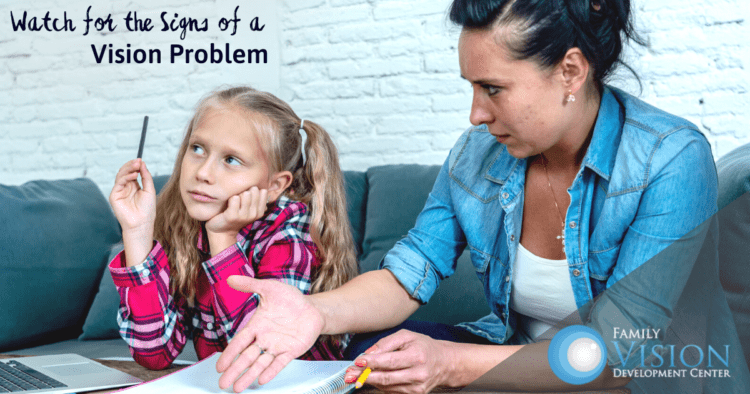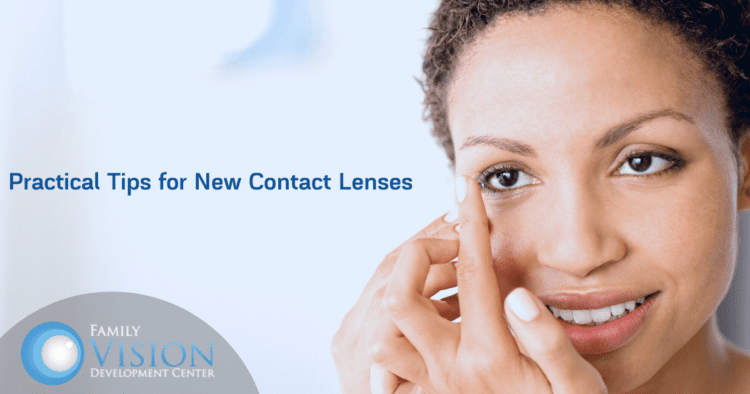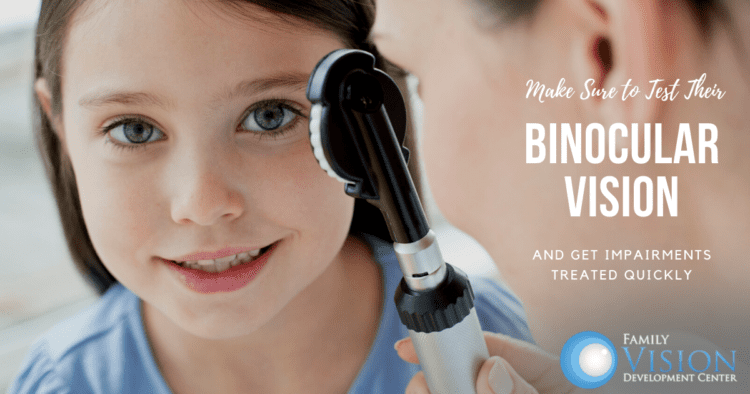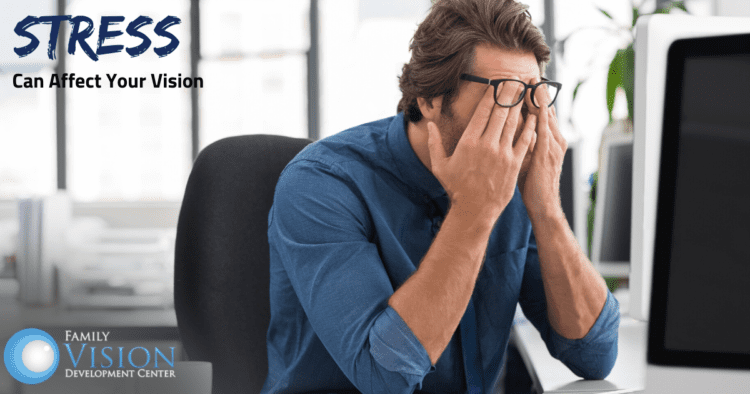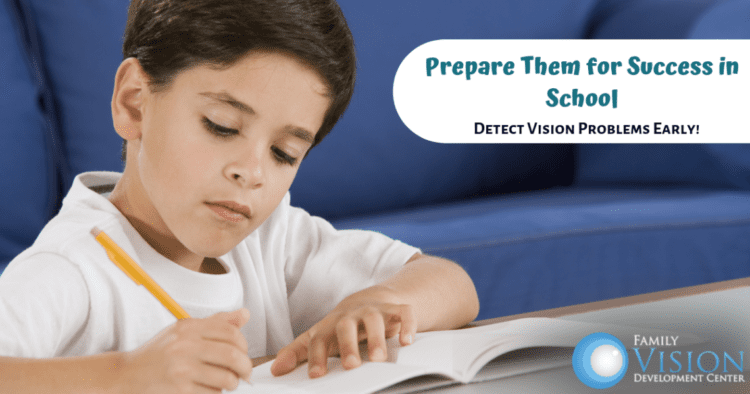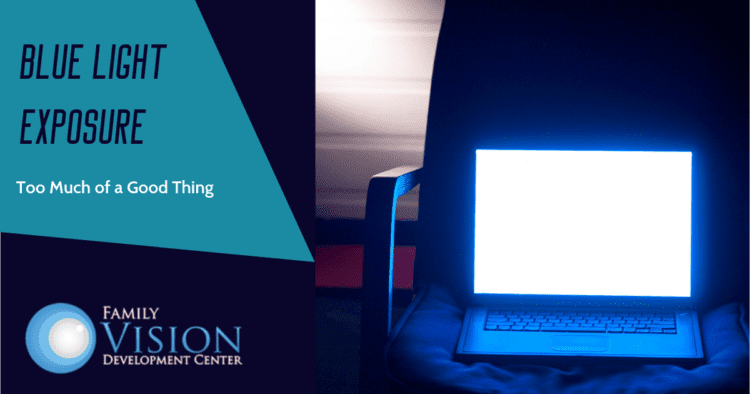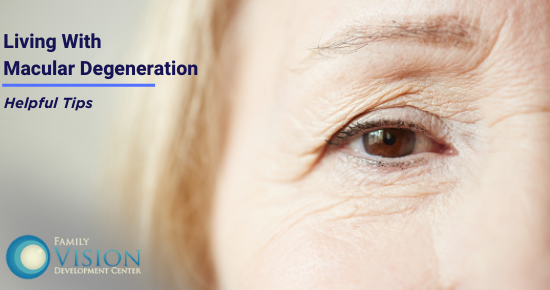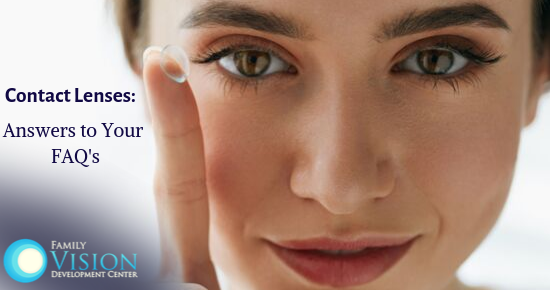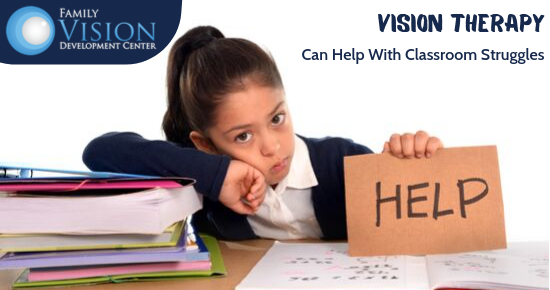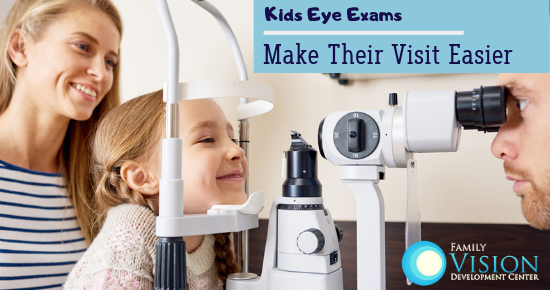Vision therapy, which is also known as vision training or visual training, is an individualized treatment program that is like physical therapy for the eyes and brain. Through customized eye exercises, patients can develop or recover normal visual skills that may have been impaired due to a wide range of vision disorders.
While individuals of all ages can benefit from vision therapy, it can be especially helpful for young children with learning disabilities or those suffering from lazy eye, crossed eyes or focusing issues. Vision deficits can cause eyestrain, blurred or double vision, and headaches that make it difficult to stay focused while reading, maintaining attention in the classroom or focusing on close work. Vision therapy can help correct these visual deficits. With vision therapy, children are better positioned to achieve their full potential, both in and out of the classroom.
Could your child benefit from vision therapy? These common signs can indicate that there is an underlying vision problem.
- Your child has poor hand-eye coordination, which may be evident in poor handwriting, motor coordination, athletic performance, etc.
- Your child has problems walking or running, and frequently drops objects or bumps into things
- Your child holds a book or object unusually close
- Your child closes one eye or covers the eye with his/her hand
- Your child omits or confuses small words when reading
- Your child reverses words when reading (e.g., “no” for “on”) or transposes numbers (e.g., “21” for “12”)
- Your child complains frequently of headaches, eyestrain, nausea, dizziness and/or motion sickness
- Your child frequently avoids or objects to doing homework
- Your child exhibits behavior problems in school
Regular eye exams can detect vision problems that standard screenings do not
Even though your child may receive vision screenings at school, these tests do not diagnose the many vision conditions that a comprehensive eye exam does. It is important to be diligent when it comes to your child’s vision – especially if you notice any of the above signs of a problem. Vision therapy can be an excellent form of treatment, and a successful outcome is even greater when issues are diagnosed early on. At Family Vision Development Center, vision therapy is our specialty. Dr. Martin is specially trained to treat a variety of vision related conditions using complete vision therapy services designed to restore and improve visual efficiency. Contact us today at 630-862-2020 or visit us online to schedule your appointment.
Contacts are a smart choice for individuals who are active and dislike the feeling of wearing glasses. However, the process of caring for and getting used to new contacts can take a week or two. Navigate the transition with ease by learning how to properly care for contacts and becoming familiar with common symptoms that occur when you first wear them.
What to Expect When First Wearing Contacts
As with any new eye prescription, it may take a few days for your eyes and brain to adjust to the changes. New prescriptions may cause mild headaches or slight dizziness. If this persists after the first week, it may be a sign that your prescription needs to be adjusted.
New contacts can also sometimes cause mild eye irritation during the first few days of use as you get used to the new sensation. You may feel uncomfortable that there is something in your eye or notice when your lenses begin to dry out. After a day or two, these symptoms typically go away. Remember that these minor issues are normal, and all a part of getting used to something new. However, if you continue to experience eye irritation after a week, or have any concerns at all, contact us for recommendations.
Practice, Practice, Practice!
Getting comfortable putting in your new contacts can take some time. It can be a strange feeling touching your eye like that and you may wonder if you are doing it correctly. We will give you specific instructions during your appointment, but the more you practice, the easier it will become. Soon it will become a very natural part of your daily routine.
Caring for Your New Contacts
One of the most common causes of eye irritation is improper care for contact lenses. There are certain things you should always remember when caring for your new contacts:
- Always wash your hands before and after touching your eyes to avoid spreading bacteria. Also, be certain that all soap residue is thoroughly rinsed before touching the lenses.
- Remember that tap water is not appropriate to clean your contact lenses. Only use the contact lens solution provided by your eye doctor to avoid damaging the lenses and to ensure they are disinfected properly.
- Storing your new contacts properly is another very important task. Always use fresh solution to store your contacts overnight. Reusing contact solution may cause eye irritation or infection.
Proper Follow-Up Care
Remember that caring for your new contacts also includes getting regular eye exams to make sure that problems do not go undetected. Serious infections can occur if lenses are not cared for properly, so visiting us on a regular basis can help ensure proper use and address any prescription issues. Contact us at 630-862-2020 to make your appointment for your new contacts this year! We have a wide variety of choices available in the latest lens technology, and can find the right lenses for your specific lifestyle.
The human visual system is a complex network including the eye, ocular nerves, and key brain areas that process visual information. Under most circumstances, we use information from both eyes to create a single visual image. This ability to converge information from both eyes is called binocular vision. However, in some cases, the eyes fail to seamlessly meld visual information into a coherent image. This leads to binocular vision impairments which can cause problems seeing things correctly.
How Does Binocular Vision Work?
Unlike some other animals, human eyes are both set on the front of the face, permitting binocular vision. Each eye has a field of view, which is the area that you can see when you close one eye. The center of the eyes’ fields of view overlap with one another, although visual information in the periphery can only be detected by one eye. This information is transmitted to an area of the brain which synthesizes the overlapping visual information to make a single coordinated image.
Examples Of Binocular Vision Problems
When the eyes are not working together properly, it can cause full or partial impairments to vision and depth perception. This can result in conditions like Amblyopia (“lazy eye”), strabismus (cross-eye), convergence insufficiency, double vision or eye tracking problems. A child or adult that has one of these conditions can experience difficulty reading or completing homework, playing sports, driving or even tying a shoe.
Binocular vision impairments are not always obvious. For example, a child may suffer from Amblyopia but may not have an obvious turning of one eye. This is why early detection is so important! Often times, these conditions can only be accurately detected in a comprehensive eye exam. School screenings are not enough, so be sure to bring your kids in to Family Vision Development Center on a regular basis to detect any problems while they are still easily treatable.
Vision Therapy Can Help Correct Binocular Vision Impairment
Some binocular vision disorders can be treated with eyeglasses, but often times the best choice of treatment is a vision therapy program. Family Vision offers highly specialized programs in our office that are customized for each patient. This treatment, known as physical therapy for the visual system, uses special eye exercises to develop or regain normal visual skills. As a treatment for binocular vision issues, it is much more effective than surgery or glasses alone.
Contact us at 630-862-2020 to schedule an appointment or learn more about Family Vision Development Center at https://www.fvdcpc.com/.
We’ve all been cautioned to reduce our stress levels as much as possible. Stress can have numerous negative effects on the body such as headaches, anxiety, fatigue, depression or trouble sleeping. But a lesser-known effect is how it can impact your vision.
Why Stress Affects Vision
When you get stressed, your body produces adrenaline, which speeds up your heart rate. This means more blood flows to essential functions like your internal organs, and less blood gets to your extremities, like your eyes. High levels of adrenaline can cause pressure on the eyes, while prolonged surges of cortisol (another hormone released when stress occurs) can lead to glaucoma or optic neuropathy.
Which Vision Problems Can be Caused by Stress
Some signs that stress may be reason behind your vision problems can include:
- Eye twitching
- Eye strain
- Sensitivity to light
- Very wet or very dry eyes
- Tunnel vision (loss of some peripheral vision)
- Blurry vision
- Eye floaters (tiny spots that swim across your vision)
Not only does stress have the capability to produce these new vision issues, but some studies conclude that it can actually worsen already-existing problems from diseases such as glaucoma, diabetic retinopathy or age-related macular degeneration.
Tips to Alleviate Some Stress
If you suspect that your eye problems are related to stress, there are some tactics you can employ to try to relieve some of your symptoms. Try to relax through deep breathing or meditation, get some extra rest and do your best to eat as healthy as possible while increasing your exercise. Remember to take breaks often to give your mind a chance to rest!
Certainly, believing that you have a serious vision condition developing can add to your stress levels. Which can lead to worsening of your symptoms. And so on. The best way to determine the cause of your vision problems is through a comprehensive eye exam here at Family Vision Development Center. Once we have thoroughly examined your eyes and diagnosed any conditions, we can start to develop a plan to correct any issues. Contact us at 630-862-2020 or visit us online to learn more.
When a child has vision problems, it can affect many areas of their daily life, including their learning ability. And it may not be as evident as blurred vision – a child could have perfectly clear eyesight, but still have vision issues that can prevent them from achieving success in school.
Types of Vision Problems
There are several types of vision problems, all of which can affect your child’s ability to read, write and succeed in the classroom in different ways. The following are some common vision problems in children that may interfere with learning ability.
Children with a refractive error have an irregularly shaped cornea that does not bend light properly. This can cause blurred vision, difficulty reading things up close or a crossing of the eyes. If your child holds a book very close to their eyes or squints when trying to read or see the front of the classroom, they may be suffering from a refractive vision problem.
- Functional Vision Problems
These refer to problems affecting the way that the eyes and brain work together. This can lead to problems in eye teaming (binocularity), accommodation (i.e., the ability of the eye to focus on an object at different distances), hand-eye coordination, peripheral vision or fine eye movements. A child with a functional vision problem may experience double vision, transposing letters, confusing similar words, difficulty with reading, spelling and math, and poor performance in sports.
- Perceptual Vision Problems
Perceptual vision problems are characterized by difficulty understanding and identifying what one sees. A child with poor visual perception may have 20/20 vision, but might have trouble distinguishing between two similar letters (such as u and n), putting a puzzle together or finding a pair of matching socks in a drawer. Other signs of a visual perception disorder could include skipping words or lines when reading, memorization trouble, or understanding a map.
While parents may be quick to assume that their child’s learning ability is determined by their study habits, or even genetics, they may not even think to look at their vision. A comprehensive eye exam at Family Vision Development Center can uncover any vision conditions or disorders that can lead to poor performance in school. Vision therapy programs are a very effective way to treat these types of vision conditions, and early detection often provides more opportunity for treatment options. Contact us today at 630-862-2020 or visit us online to schedule an appointment.
Blue light is produced naturally by the sun and is also generated by computer monitors, smartphone screens and other digital devices. Although the light has some beneficial effects, exposure can increase your eyestrain risk and even affect your central vision.
What Is Blue Light?
The rays of the sun may appear to be colorless, but they’re actually made up of red, blue, orange, yellow, green and violet hues. Blue rays emit higher amounts of energy, and therefore they’re more likely to affect your eyes.
Much of your exposure to blue light comes from the sun, but you can’t avoid exposure simply by staying indoors. In addition to computer monitors and smartphones, it is produced by tablets, LED and fluorescent lights, LED light from TVs and compact fluorescent light bulbs. Blue light plays an important role in maintaining the sleep/wake cycle, regulating your mood and keeping your memory sharp – but too much of it can keep you awake at night and can be harmful to your eyes.
Too Much Exposure Can Cause Eyestrain
If you have ever experienced blurred vision, headaches or burning, itching eyes after spending hours in front of a digital screen, it could be the result of prolonged exposure to blue light. Staring at electronic devices for extended periods of time can result in digital eye strain. This occurs when your eyes continually try to focus on a screen, which pulls at the eye muscles until they become fatigued.
Central Vision May Be Affected by Blue Light
Blue light penetrates all the way to the retina (the inner lining of the back of the eye) and can cause damage to the light-sensitive cells in the retina. Long-term exposure may increase your risk of developing age-related macular degeneration (AMD), which occurs when the retina deteriorates and results in vision loss in the center field of vision.
Blue light exposure can also pose a higher risk to those who have recently had cataract surgery. A cataract serves as a natural protective lens for the eye, so when the cataract is removed, your exposure increases and precautions should be taken to filter out blue light when possible.
Protecting Your Eyes From Blue Light
Some blue light is good, and necessary, as it can boost alertness, help with memory and cognitive function and elevate mood. However, too much is not good and the following precautions can help protect your eyes from excessive harmful blue light exposure.
- Buy a Filter – Adding a blue light filter to your screens can improve contrast and lower the amount of blue light that your eyes absorb.
- Take Breaks – Taking frequent breaks from your computer, tablet or phone helps lower your exposure and also gives your eyes a chance to rest. Breaks don’t have to be long. If your day is hectic, simply looking away from your computer for a minute or two every 20 minutes can be helpful.
- Try New Glasses – If you spend much of your day working on a computer, you may want to consider buying a pair of prescription computer glasses. The glasses block blue light, improve contrast and help reduce eyestrain.
- Consider Blue Light-Blocking Lenses After Cataract Surgery – Special lenses that reduce blue light transmission can be used in place of clear lenses after your cataract surgery.
Family Vision Development Center in Aurora assists in providing important information regarding the safety of your eyes, as well as providing crucial services such as comprehensive eye exams that indicate vision conditions like AMD, vision therapy services to treat certain disorders and a wide selection of prescription glasses to effectively correct your vision. Contact us at 630-862-2020 to schedule your appointment or learn more about our practice here: https://www.fvdcpc.com/about/
Macular degeneration is not a diagnosis you want to receive. Unfortunately, as many as 11 million people in the U.S. are living with some form of the disease. While there is no current cure for macular degeneration, there are some things you can do to make daily living a little easier.
What is Macular Degeneration
Macular degeneration is a condition that affects the central part of the retina (the macula) which causes blurred or loss of vision in the central field of vision. It may happen very slowly at first but become more severe as it progresses, and it may occur in one or both eyes. And while it may not cause complete blindness, losing your central vision can make activities like driving, cooking or reading much more difficult.
How to Change Your Lifestyle After a Macular Degeneration Diagnosis
There is no quick fix for macular degeneration, but a change of lifestyle can definitely help to improve symptoms or prevent it from getting worse.
- Quit smoking – studies have shown a strong link between smoking and developing macular degeneration, so the best thing to do for the health of your eyes is to quit immediately.
- Eat a variety of nutritious foods – the antioxidants in fruits and vegetables are good for retinal health and can help stop progression of the disease. And fish contains omega-3 fatty acids which are thought to improve eye health.
- See your doctors regularly – visit your primary care doctor to keep an eye on your blood pressure and cholesterol, and see your eye doctor for regular eye exams to monitor the disease and discuss alternative treatment options if necessary, as well as adjust your eyeglass prescription when appropriate.
- Improve lighting in the house – using brighter lamps that cover the whole room, desk lamps for targeted light or under-cabinet lighting in the kitchen can all aid in vision around the house.
- Take advantage of low vision electronic aids – there are a multitude of low vision products out there that can help when your eyesight is not as good as it used to be. Try handheld or desktop magnifiers, large-button phones, clocks with large numbers, or try audio books if reading becomes difficult.
It is important to remember – the only way to diagnose macular degeneration is through a comprehensive eye exam, which is why it is so important to visit us on a regular basis. Early detection can allow for more treatment options, and early treatment can help stop the disease from progressing. Don’t put off your eye exam – contact Family Vision Development Center at 630-862-2020 or visit us online to learn more.
Additional information can be referenced here.
There are different options for vision correction, and what you choose depends on a number of different factors. Family Vision Development Center offers a wide range of options for both eyeglasses and contact lenses. We will thoroughly explain the benefits of each during your comprehensive vision exam, but here are some basic facts about contacts to get you started:
Can I Wear Contact Lenses?
Most people are able to wear contact lenses safely and comfortably. There are contact lenses that correct for nearsightedness, farsightedness, astigmatism, and other vision problems. A comprehensive eye exam can determine what lenses are appropriate for you.
Are Contact Lenses Safe For My Eyes?
Millions of people wear contact lenses without any difficulties. Following recommendations for inserting, removing, cleaning, storing, and replacing contacts typically keeps your eyes safe and healthy. However, if you have specific concerns about contact lens safety, we are here to make sure your questions get answered.
What Is The Difference Between Hard And Soft Lenses?
Soft contact lenses are made of plastic combined with water. Soft lenses allow oxygen to pass through the material to your cornea, nourishing and soothing the surface of your eye. Rigid gas permeable contact lenses, sometimes called “hard lenses” are made from a stiffer, oxygen-permeable material. They are often used by individuals with astigmatism or higher-order aberrations.
How Often Should I Change My Contact Lenses?
The frequency with which you should dispose of lenses depends on the contact lens type. Some lenses are made to be disposed of each night, while others may last several weeks. Talk to us during your appointment and read the instructions on your contact lens package to determine the replacement schedule for your lenses.
Is It Possible To Lose A Contact Behind My Eye?
No. If you rub your eyes or swim underwater with contacts, it is possible to dislodge your contacts. Usually, they can be found under your upper eyelid and removed without difficulty.
How Long Does It Take To Adjust To Wearing Contacts?
If you’re not used to wearing contacts, you may notice them or feel slight discomfort for a day or two. As you become accustomed to the lenses, you will no longer even notice that they’re there.
There are a lot of variables to consider when choosing contact lenses. Think about your typical routine and talk to us during your eye exam to find the perfect selection for your lifestyle. Visit Family Vision Development Center in Aurora or contact us at 630-862-2020 to schedule your appointment.
Vision therapy, also referred to as vision training, neuro-vision therapy, or vision rehabilitation, is an optometry subspecialty. Vision therapy is a type of physical therapy for the eyes and brain, and is used to develop, improve and/or enhance visual function. Vision therapy can be beneficial for individuals of all ages. The goal of treatment is to work toward eliminating vision problems and improving a patient’s quality of life by maximizing vision performance and comfort.
How Vision Therapy Works
A vision therapy program involves a series of eye “exercises” and procedures, performed in the office by our highly-trained visual therapists, and specifically tailored to each individual patient. The in-office programs may involve the use of specialized equipment such as corrective or therapeutic lenses, prism lenses, balance boards or visual-motor-sensory integration training devices. Patients may also be given at-home exercises on a weekly basis in order to reinforce the progress made in the office.
A successful program can help a patient develop their visual skills and abilities, improve the efficiency of their vision, or change how they process or interpret visual information.
Who Benefits From Vision Therapy?
Vision therapy is especially beneficial for individuals with ocular motor dysfunctions, binocular dysfunctions, accommodative dysfunctions, visual motor and visual perception disorders, learning-related vision problems, traumatic brain injuries, myopia control, amblyopia, and strabismus. Vision therapy may also be prescribed for patients seeking sports vision enhancement.
An effective therapy program is customized to meet the needs of an individual. For example, if you are seeking sports performance enhancement, you will receive therapy designed to improve visual processing speeds, reaction times, visual endurance, accuracy, and eye teaming. Individuals with vision-related learning difficulties will receive therapy that focuses specifically on improving the visual input skills and visual processing skills required for efficient reading, writing, spelling and mathematics.
Family Vision Development Center Offers Expert Vision Therapy Programs
At Family Vision, our specialty is neuro-optometric rehabilitation and vision therapy. Dr. Martin is specially trained to treat a variety of vision related conditions using the most advanced and up-to-date vision therapy techniques, and Dr. Santoyo-Johnson is a board-certified Fellow in Light Therapy by the College of Syntonic Optometry. Our experience and dedication to the field allows our patients to feel confident that they are receiving the best care possible. Contact us at 630-862-2020 for more information or request an appointment online.
Additional information can be referenced here.
A visit to the eye doctor can be a little overwhelming for young patients, especially if it’s the first visit. Even with a friendly, welcoming the staff, small children may feel shy or find vision testing machines and gadgets a little intimidating. Luckily, parents can make an optometrist visit much less daunting by following a few of these suggestions.
Don’t Keep Your Child in Suspense
Whether you’re 3 or 33, new situations are a lot less scary if you know what to expect. Before your child’s optometrist visit, explain the purpose of the visit. (You want to make sure he or she can see well.) Use age-appropriate language to explain the various steps in the eye examination process, which usually include a review of your child’s medical and vision history, a physical examination of the eyes and eyelids, and a visual assessment to determine if your child can see clearly.
During the assessment, your son or daughter will be asked to look at images or letters. Preschoolers may view several large capital Es that face in different directions. They’ll use their hands to indicate which direction the arms of the Es point. If your child knows the letters of the alphabet, he or she will read the traditional Snellen eye chart.
Eye drops may be used to dilate your child’s pupils. Dilation helps the optometrist view the retina, a light-sensing layer of cells that line the back of the eye. Although the drops aren’t painful, they will make your son or daughter’s vision a little blurry. Be sure to mention that the eye doctor will also look in your child’s eyes with a small light during the examination.
Choose the Best Appointment Time
Kids, like all of us, tend to feel a little more energetic at certain times of the day. If you want to make the optometrist visit as pleasant as possible, choose a time when your son or daughter is usually happy and well-rested. Scheduling visits during your child’s usual meal or nap time, immediately after a nap, or at the end of a long day can result in a cranky child who is reluctant to participate in the vision assessment.
Appointments usually last an hour or less, but may take longer if your child’s eyes are dilated or if you want to select eyeglass frames at the end of the visit.
Distract and Engage
The eye doctor will make every effort to see your child at the appointed time, but that doesn’t mean you won’t spend a little time in the waiting room completing paperwork. Prepare for any possible waiting time by bringing a few toys or books from home to keep your little ones occupied.
Offer a Little Reassurance
Some kids hop on the exam chair without prompting, while others aren’t quite as brave. If your young child is nervous or anxious, feel free to hold him or her in your lap during the assessment and examination. Older children may feel more confident if you stay by their sides or sit in a nearby chair during the visit with the optometrist.
When Should You Take a Child to Their First Optometrist Visit?
The American Optometric Association recommends that children visit the optometrist for the first time at 6 – 12 months old, followed by another visit between 3 and 5 years of age, then yearly visits from ages 6 to 18. However – it is important to remember that these are just guidelines. If you notice any issues with your child’s vision, always bring them in. Early detection of vision disorders can make a difference in the effectiveness of treatment, so it is better to be safe. Consult this Parent’s Checklist to look for early signs of vision impairment.
Contact Family Vision Development Center at 630-862-2020 or request an appointment online HERE
